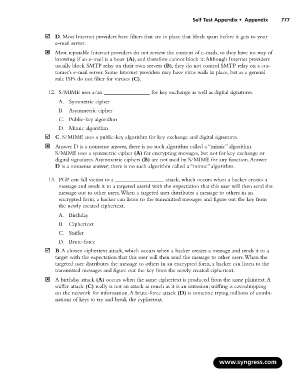Page 793 - StudyBook.pdf
P. 793
Self Test Appendix • Appendix 777
D. Most Internet providers have filters that are in place that block spam before it gets to your
e-mail server.
Most reputable Internet providers do not review the content of e-mails, so they have no way of
knowing if an e-mail is a hoax (A), and therefore cannot block it.Although Internet providers
usually block SMTP relay on their own servers (B), they do not control SMTP relay on a cus-
tomer’s e-mail server. Some Internet providers may have virus walls in place, but as a general
rule ISPs do not filter for viruses (C).
12. S/MIME uses a/an ________________ for key exchange as well as digital signatures.
A. Symmetric cipher
B. Asymmetric cipher
C. Public-key algorithm
D. Mimic algorithm
C. S/MIME uses a public-key algorithm for key exchange and digital signatures.
Answer D is a nonsense answer, there is no such algorithm called a “mimic” algorithm.
S/MIME uses a symmetric cipher (A) for encrypting messages, but not for key exchange or
digital signatures.Asymmetric ciphers (B) are not used by S/MIME for any function.Answer
D is a nonsense answer; there is no such algorithm called a “mimic” algorithm.
13. PGP can fall victim to a _________________ attack, which occurs when a hacker creates a
message and sends it to a targeted userid with the expectation that this user will then send the
message out to other users.When a targeted user distributes a message to others in an
encrypted form, a hacker can listen to the transmitted messages and figure out the key from
the newly created ciphertext.
A. Birthday
B. Ciphertext
C. Sniffer
D. Brute-force
B.A chosen ciphertext attack, which occurs when a hacker creates a message and sends it to a
target with the expectation that this user will then send the message to other users.When the
targeted user distributes the message to others in an encrypted form, a hacker can listen to the
transmitted messages and figure out the key from the newly created ciphertext.
A birthday attack (A) occurs when the same ciphertext is produced from the same plaintext.A
sniffer attack (C) really is not an attack as much as it is an intrusion; sniffing is eavesdropping
on the network for information.A brute-force attack (D) is someone trying millions of combi-
nations of keys to try and break the cyphertext.
www.syngress.com

